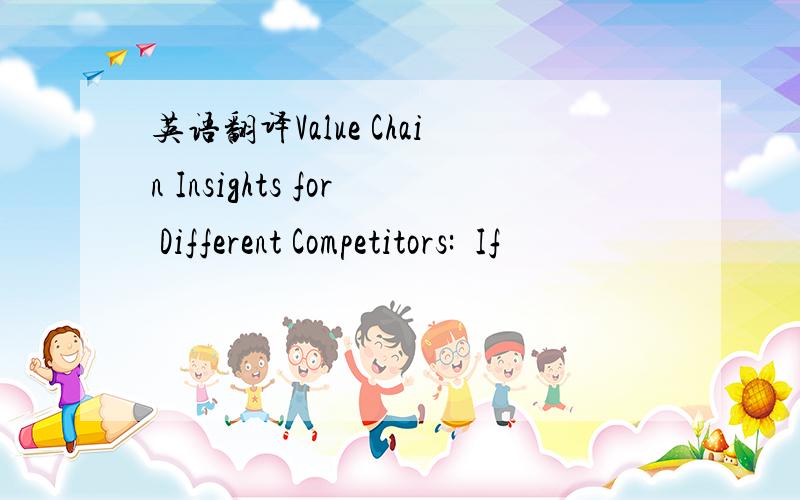英语翻译Value Chain Insights for Different Competitors:•If
来源:学生作业帮 编辑:搜搜考试网作业帮 分类:英语作业 时间:2024/04/26 01:56:40
英语翻译
Value Chain Insights for Different Competitors:
•If competitor A (the most fully integrated company in the exhibit) calculates the Return on Assets at each stage of the chain by adjusting all transfer prices to competitive market levels,it could highlight potential areas where the firm could more economically buy from the outside instead of "making" (strategic choice of make or buy).For example,most of the "fully integrated" forest product companies still use independent loggers to cut their trees on the way to their mills.
•With a complete value chain,competitors B,C,D,E,F,and G might be able to identify possibilities to forward or backward integrate into areas which can enhance their performance.Westvaco,for example,recently stopped manufacturing envelope paper although it still owns a large envelope converter.Champion International,on the other hand,has sold its envelope converting business but still produces envelope paper.Both choices,although apparently inconsistent,could be plausible given the specific strategies of Westvaco and Champion.
•Each value activity has a set of unique cost drivers that explain variations in costs in that activity [Shank,1989].Thus,each value activity has its unique sources of competitive advantage.Companies are likely to face a different set of competitors at each stage.Some of these competitors would be more fully integrated companies and some of them would be more narrowly focussed specialists.For instance,firm D in Exhibit I faces competition from firms A,C,and G in the paper mill stage.Yet,firms A,C,and G bring very different competitive advantage to this stage of the value chain vis-a-vis firm D.It is possible for firm D to compete effectively with firms A,C,and G only by understanding the total value chain and the cost drivers that regulate each activity.For example if lack of "scope" (vertical integration) is an important structural driver of paper mill cost,A has a significant advantage and D a significant disadvantage in this marketplace.
•Since each firm illustrated in Exhibit 1 is both a buyer and a seller somewhere within the chain,calculating the profit (and ROA) earned at each stage can help in understanding the relative power of buyers versus sellers at that stage.For example,comparing the returns for firm E versus F can help identify the relative power within the chain of the converting stage for which E is a supplier but F is a buyer.This then could help the firms in identifying ways to exploit their linkages with their suppliers as well as with their customers to reduce costs or enhance differentiation or both.
Value Chain Insights for Different Competitors:
•If competitor A (the most fully integrated company in the exhibit) calculates the Return on Assets at each stage of the chain by adjusting all transfer prices to competitive market levels,it could highlight potential areas where the firm could more economically buy from the outside instead of "making" (strategic choice of make or buy).For example,most of the "fully integrated" forest product companies still use independent loggers to cut their trees on the way to their mills.
•With a complete value chain,competitors B,C,D,E,F,and G might be able to identify possibilities to forward or backward integrate into areas which can enhance their performance.Westvaco,for example,recently stopped manufacturing envelope paper although it still owns a large envelope converter.Champion International,on the other hand,has sold its envelope converting business but still produces envelope paper.Both choices,although apparently inconsistent,could be plausible given the specific strategies of Westvaco and Champion.
•Each value activity has a set of unique cost drivers that explain variations in costs in that activity [Shank,1989].Thus,each value activity has its unique sources of competitive advantage.Companies are likely to face a different set of competitors at each stage.Some of these competitors would be more fully integrated companies and some of them would be more narrowly focussed specialists.For instance,firm D in Exhibit I faces competition from firms A,C,and G in the paper mill stage.Yet,firms A,C,and G bring very different competitive advantage to this stage of the value chain vis-a-vis firm D.It is possible for firm D to compete effectively with firms A,C,and G only by understanding the total value chain and the cost drivers that regulate each activity.For example if lack of "scope" (vertical integration) is an important structural driver of paper mill cost,A has a significant advantage and D a significant disadvantage in this marketplace.
•Since each firm illustrated in Exhibit 1 is both a buyer and a seller somewhere within the chain,calculating the profit (and ROA) earned at each stage can help in understanding the relative power of buyers versus sellers at that stage.For example,comparing the returns for firm E versus F can help identify the relative power within the chain of the converting stage for which E is a supplier but F is a buyer.This then could help the firms in identifying ways to exploit their linkages with their suppliers as well as with their customers to reduce costs or enhance differentiation or both.

从价值链视角看不同竞争者
如果竞争者A(展览中整合最为完全的公司)根据市场竞争水平调整交易价格,并以此计算每个阶段的资产回报率,它就可以突出公司的某些潜力领域,在这些领域中公司可以更经济实惠地从外部购买而非进行自行制造(外部购买和自行制造之间的战略选择).例如,机试是完全整合的森林产品公司,在伐木时也仍然实用独立的记录器,然后上报到制造厂.
在完整价值链中,竞争者B,C,D,E,F,G可能会考虑在他们可以表现得更加良好的领域进行前向整合或者后向整合的可能性.比如westvaco公司(美国造纸业巨头)近期停止生产信封用纸,尽管它拥有一台大的信封转换器.相反的,冠军国际公司(也译锦标国际公司,又一造纸业巨头)出售了它的信封转换业务,却仍然生产信封.虽然看上去很矛盾,然而如果考虑到具体战略,westvaco和champion两个公司的选择都能得到合理解释了.
每一个价值活动都有一系列独特的成本来源来解释这项活动的成本变化[shank,1989年].因此,每一项活动都有自己独特的竞争优势来源.在每个阶段,公司都可能遇到不同的竞争对手.有的整合得更加完全(宽度),有的则专注于某个领域(深度).例如,展品1中的D公司在造纸阶段可能会遇到来自A,C,G公司的竞争.而且相比起D公司,A,C,G公司在这个阶段的价值链上有竞争优势.那么,只有通过了解整个价值链和每项活动的成本来源,D公司才可能和A,C,G公司完全竞争.比如说,如果D由于缺乏“范围”(垂直整合)而导致成本的重要结构化增加,那么在这个市场上,A就有了重大优势,D则处于劣势.
展品1号中的每个公司都是价值链某个环节的买家和卖家,那么计算每个环节的利润(和资产回报率)可以帮助理解再次阶段买方和卖方的力量对比.比如,在转换阶段,E是供应商,F是买方,那么比较E和F的投资回报率就可以判断出他们的相对力量强弱了.这样就能帮助企业与供应商和顾客一起找到开发利用各环节之间联系的道路,以此减少成本或加强差异化或二者兼有.
____________
论文里面好像是用实验法得出某种结论
所以exhibit 1 可能不是展品1号,而是实验1
请楼主根据具体情况斟酌.
如果竞争者A(展览中整合最为完全的公司)根据市场竞争水平调整交易价格,并以此计算每个阶段的资产回报率,它就可以突出公司的某些潜力领域,在这些领域中公司可以更经济实惠地从外部购买而非进行自行制造(外部购买和自行制造之间的战略选择).例如,机试是完全整合的森林产品公司,在伐木时也仍然实用独立的记录器,然后上报到制造厂.
在完整价值链中,竞争者B,C,D,E,F,G可能会考虑在他们可以表现得更加良好的领域进行前向整合或者后向整合的可能性.比如westvaco公司(美国造纸业巨头)近期停止生产信封用纸,尽管它拥有一台大的信封转换器.相反的,冠军国际公司(也译锦标国际公司,又一造纸业巨头)出售了它的信封转换业务,却仍然生产信封.虽然看上去很矛盾,然而如果考虑到具体战略,westvaco和champion两个公司的选择都能得到合理解释了.
每一个价值活动都有一系列独特的成本来源来解释这项活动的成本变化[shank,1989年].因此,每一项活动都有自己独特的竞争优势来源.在每个阶段,公司都可能遇到不同的竞争对手.有的整合得更加完全(宽度),有的则专注于某个领域(深度).例如,展品1中的D公司在造纸阶段可能会遇到来自A,C,G公司的竞争.而且相比起D公司,A,C,G公司在这个阶段的价值链上有竞争优势.那么,只有通过了解整个价值链和每项活动的成本来源,D公司才可能和A,C,G公司完全竞争.比如说,如果D由于缺乏“范围”(垂直整合)而导致成本的重要结构化增加,那么在这个市场上,A就有了重大优势,D则处于劣势.
展品1号中的每个公司都是价值链某个环节的买家和卖家,那么计算每个环节的利润(和资产回报率)可以帮助理解再次阶段买方和卖方的力量对比.比如,在转换阶段,E是供应商,F是买方,那么比较E和F的投资回报率就可以判断出他们的相对力量强弱了.这样就能帮助企业与供应商和顾客一起找到开发利用各环节之间联系的道路,以此减少成本或加强差异化或二者兼有.
____________
论文里面好像是用实验法得出某种结论
所以exhibit 1 可能不是展品1号,而是实验1
请楼主根据具体情况斟酌.
英语翻译Value Chain Insights for Different Competitors:•If
英语翻译Internationally recognized for his insights into teachin
英语翻译1.market oriented accounting;2.value chain costing3.targ
along the value chain
value chain accounting+英文文献
英语翻译If you have work for something you will value it more.应该
英语翻译The value chain framework highlights how a firm's produc
If this value is present.//英语翻译
customer value chain model具体是什么
英语翻译Happiness means different things to different people.For
英语翻译Different things usually stand for different feelings.Re
谁那里有关于value chain(价值链)的英文文章